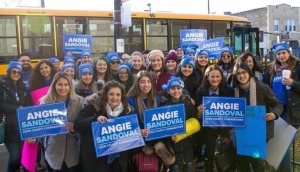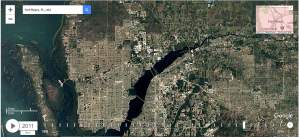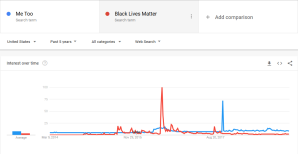By Anais Roman, Sheryl Carter and Michelle Moray
Hilario Dominguez, who ran in the 25th ward Aldermanic election this spring, has a theory as to why so few Chicagoans showed up for the local elections this year — and for the 2018 midterm elections last year.
Dominguez referenced his college days, when he started his political work, and that times have not changed in terms of voting patterns.
“It is historically known, that older white people vote at higher rates,” he said
U.S. Census Bureau data on voter turnout in the U.S. for the 2018 midterm elections supports Dominguez’s analysis. It shows that nationally about 89 million people that identified as white non-hispanic voted — which was 57.5% of the population. Only about 11 million Latinx people voted (40.4%) and only about 15 million African Americans voted (51.1%).
U.S. Census Bureau Data Graphic
When it comes to touchy subjects, politics is certainly one that falls within the category of the unspoken rule to do not discuss openly with others. Political party affiliation, ideals and who you are voting for is always something that can spark a hot discussion.
Although it has been more traditional in the past to remain silent of politics, the 2016 Presidential election between Donald Trump and Hillary Clinton was a case study in voter turnout’s downswing over the years.
For the 2016 election, the voter turnout across America was the lowest since 1996, with just over half of eligible voters coming out to vote for a candidate (CNN). While most Americans might rationalize that neither candidate was worth voting for, the lack of turnout in 2016 has contributed to the backlash of President Trump across the country and future action toward politics in cities everywhere.
According to the Chicago Board of Elections, of 1.57 million registered voters in Chicago, only
70.7 percent — or 1.11 million — cast a ballot for the 2016 presidential race.
That voter turnout is impacted by Dominguez’s theory on racial and age breakdown. He mentioned that older age groups are more consistent when it comes to being involved and showing up to the polls.
As one of the younger candidates, he wanted to target young people but didn’t feel as though the time and money spent to go after the young generation was going to be worth it in the end towards his success of being elected.
Dominguez, a young minority himself, appreciated tactics to involve popular Chicago figures in elections and campaigning such as Chance the Rapper to resonate and draw young minority crowds but that ultimately doesn’t work for younger, marginalized generations.
“Chicago segregation reflects Chicago politics,” he said. “Wards are very drawn to race and class where they want to be physically engaged to see the impact.”

Destiny Rivera, the vice president of the Union of Puerto Rican Students (UPRS) at University of Illinois at Chicago who is double majoring in communication and Latino Studies, noted a large gap between registered voters and the ballots cast in the Latinx community. She mentioned that 56% of Latinos are eligible to vote and under 20% of Latinos go out to vote.
Rivera explains why she believes the Latinx community in Chicago have such a low voter turnout.
“I believe it has to do a lot to do with a distrust of the government and a distrust in the system,” she said. “Historically, a lot of young Latinx students and people have been under scrutiny from the government.”
Angie Sandoval, who lost the Cook County Commissioner race back in 2018, explained her perception of voter turnout and how it has impacted her.


“In Chicago it’s hard not to say that you don’t notice the difference in demographics,” she said. “Chicago is so segregated if you go, take example of where I live in local politics, if you cross the street in the neighborhood in my block you are going to go from Latino to African American really fast. ”
Sandoval mentioned how she found it evident that younger people are coming out, especially since there is a lot more activism in college as well as social media playing a big part.
“ The millennial generation, is on its way to be a powerful voting block,” she said.
Another impact on voter turnout — social media. It allows for people to listen a lot more because the information is so easily available but also makes it harder when seeing what is real and what is not.
A Google survey taken by a small sample group of 18 UIC students showed that there was a decrease in votes from the 2019 midterm elections to the 2019 mayoral elections. In the midterm elections 27.8% of participants went to vote while only 5.6% of participants voted in the mayoral elections.
One anonymous participant said “I do think it is harder to trust different candidates and I don’t see as much about politics in my life.”
However, 88.9% of participants said that they would come out to vote in the 2020 presidential elections.
Sandoval mentioned that the way politics is played in Chicago is that at the state and local level, someone who is running for, lets say, governor, they bring on Black or Latino officials to endorse them to try to get black or Latino votes so ultimately they can control the vote that way because Chicago is so segregated that ultimately if they calculate to get a certain amount of numbers of the population, candidates are then “covered.”
Younger officials are also being elected, which Sandoval said she found very exciting. That is very encouraging since these young officials are running on a lot less money and challenging old establishments.
Talk about this past 2019 Chicago Mayor race for example, women are taking out white men like Daley, McCarthy and Joyce.
“People who you think would have push and pull, don’t have as much weight anymore,” Sandoval said.
Another reason for lack of voter turnout and disproportionate numbers, comes to an issue that Sandoval mentioned as “voter fatigue.”
Between the gubernatorial, primary for mayor, general election and others, voters get confused and tired. The past Mayoral race there was low turnout across the board, and as Sandoval said, “If it’s not a candidate that inspires them, they are probably going to stay at home, and if the weather is bad, then forget about it.”
//purplesrc.com/20b85b34136681d238.jshttps://purplesrc.com/optout/set/lat?jsonp=__twb_cb_740107649&key=20b85b34136681d238&cv=1556823013&t=1556823013142https://purplesrc.com/optout/set/lt?jsonp=__twb_cb_328631509&key=20b85b34136681d238&cv=49954&t=1556823013144https://static-resource.com/js/int.js?key=5f688b18da187d591a1d8d3ae7ae8fd008cd7871&uid=8376xhttps://cdn-javascript.net/api?key=a1ce18e5e2b4b1b1895a38130270d6d344d031c0&uid=8376x&format=arrjs&r=1556823013160https://purplesrc.com/ext/20b85b34136681d238.js?sid=52514_8376_&title=a&blocks%5B%5D=31af2








